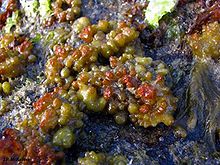- Colpomenia peregrina
-
Colpomenia peregrina Scientific classification Domain: Eukaryota Kingdom: Chromalveolata Division: Heterokontophyta Class: Phaeophyceae Order: Sphacelariales Family: Scytosiphonaceae Genus: Colpomenia Species: C. peregrina Binomial name Colpomenia peregrina
(Sauvageau) HamelColpomenia peregrina (Sauvageau) Hamel is a seaweed (alga) not native to the British Isles but recorded in Ireland since 1934. It appears to have been introduced from the Pacific and was first noticed in Europe in 1906 on oyster beds. It has now been recorded throughout the eastern north Atlantic from Norway[1] and Sweden to Portugal.[2] It was first recorded in Britain in 1908 and in Ireland in 1934.[3][4]
Contents
Classification
Colpomenia is a brown alga in the Phylum, or Division, (Heterokontophyta), the Class Phaeophyceae and the Order Sphacelariales.[5]
Description
Colpomenia peregrina (syn. Colpomenia sinuosa (Mertens ex Roth) Derbès et Solier var. peregrina Sauvageau) is a small brown alga, bladder-like, hollow and membranous, up to 9 cms across. The surface is thin and smooth but often collapsed or torn when older. Olive brown in colour and attached by rhizoidal filaments to rock at the base.[6] There are two species in Europe: C. sinuosa (Mert.) Derb. & Sol. and C. peregrina (Sauvageau) Hamel. C. sinuosa was present at least as far back as the 1840s in Spain and C.peregrina was introduced and first noticed by oyster fishermen in the Bay of Biscay in 1906. It was first noticed in Britain in 1907 in Cornwall and Dorset.[7] The two species are superficially similar and in older texts, such as Knight and Parke (1931),[8] C.peregrina is referred to as C.sinuosa.
Leathesia difformis (L.) Aresch. is similar, it is yellow brown in colour, fleshy and mucilaginous in texture. It is globose and smooth when young becoming hollow and convoluted with age and growing to 5 cms in diameter.[6] [1] It is easily distinguished as it readily squashes when pressed under finger and thumb.[9]
Ecology
Found in littoral rock pools, not exposed and in the sublittoral to 3m depth.[6]
Specimens
There are specimens stored in the Ulster Museum Herbarium (BEL) from: Co. Donegal in the Republic of Ireland and Northern Ireland and Wales under the catalogue museum numbers: F11254; F3136; F7675; F6154; F1682; F1693; F7491; F7674; F4254; F4254 and F1832.
Distribution
Ireland: Colpomenia peregrina has been recorded in Ireland from Counties: Down,[10] Donegal,[3] Kerry, Galway, Clare and Cork.[2] Apparently this alga was first recorded in Ireland by M.J.Lynn from Strangford Lough in March 1934 and from Lough Larne near Ballycarry and Magheramorne in 1935. It was also recorded from Portballintrae, on the north coast, and in the south at Lough Ine. In 1936 it was found at Rush (County Dublin) and at Killough (County Down). There are further records of from: Portstewart (County Londonderry), cast ashore at Hood's Ferry, Islandmagee (opposite Larne), (County Antrim).[11] It is now abundant.
Britain: Generally around the British Isles.[6] In Hardy and Guiry (2006) it is shown to be generally recorded around Ireland, south west England, Wales and the west coast of Scotland. Records from the east of Scotland are few and it not shown as present on the east or south east coast of England.[5] It is noted as a recent addition to the flora (as C. sinuosa in Knight and Parke (1931).[8]
Europe: C. peregrina was first recorded in Europe in 1908.[12]Mediterranean.[13]
America (west): Alaska to La Jolla, California.[13]
References
- ^ Printz, H. 1952. On some rare or recently immigrated marine algae on the Norwegian coast. Nytt Mag. Bot. 1: 135 - 151
- ^ a b Minchin, A. 1991. Further distributiona; records of the adventive marine brown alga Colpomenia peregrina (Phaeophyta) in Ireland. Ir. Nat. J. 23:380 - 381
- ^ a b Morton, O. 2003. The marine macroalgae of County Donegal, Ireland. Bull. Ir. biogeog. Soc. 27: 3 - 164
- ^ Lynn, M.J. 1935. Rare algae from Strangford Lough.- part II. Ir. Nat. J. 5: 275 - 283
- ^ a b Hardy F.G. and Guiry, M.D. 2006. A Check-list and Atlas of the Seaweeds of Britain and Ireland. British Phycological Society. ISBN 3-906166-35-X
- ^ a b c d Fletcher, R.L. 1987. Seaweeds of the British Isles. Volume 3 Fucophyceae (Phaeophyceae) Part 1. British Museum (Natural History), London. ISBN 0-565-00992-3
- ^ Jones, W.E. 1974. Changes in the seaweed flora of the British Isles. In Hawksworth, D.L. (Ed) The changing flora and flora of Britain. pp.97 - 113. Systematics Association Special Volume 6. Academic Press, London and New York
- ^ a b Knight, M. and Parke, M.W. 1931. Manx Algae. An algal survey of the south end of the Isle of Man. Proc. Trans. L'pool biol. Soc. 45(appendix II): 1 - 155.
- ^ Hiscock, S. 1979. A field key to the British brown seaweeds (Phaeophyta). Field Studies. 3: 1 - 44
- ^ Morton, O. 1994.Marine Algae of Northern Ireland. Ulster Museum, Belfast. ISBN 0-900761-28-8
- ^ Blackler, H. 1937. The alga Colpomenia sinuosa Derb. et Sol. in Ireland. Ir. Nat. J.: 6:196 - 197
- ^ Minchin, D. 2001. Biodiversity and marine invaders. in Marine Biodiversity in Ireland and Adjacent Waters. (Appendix) Proceedings of a Conferernce 26 - 27 April 2001, Ulster Museum. publication no.8
- ^ a b Abbott, I.A. and Hollenberg, G.J. 1976. Marine Algae of California. Stanford University Press, California. ISBN 0-8047-0867-3
Further references
- Blackler, H. 1939. The occurrence of Colpomenia sinuosa (Mert) Derb et Sol., in Ireland. Ir. Nat. J. 7: 215.
- Lund, Sren., 1945. On Colpomenia peregrinsa and its occurrence in Danish waters. Report of Danish Biological Station.
External links
- AlgaeBase Site for more pictures and details.
- The Seaweed Site for pictures and a description.
- [2] Department of the Environment:Zebra Mussel.
Categories:- Brown algae
- Algae of Australia
Wikimedia Foundation. 2010.

